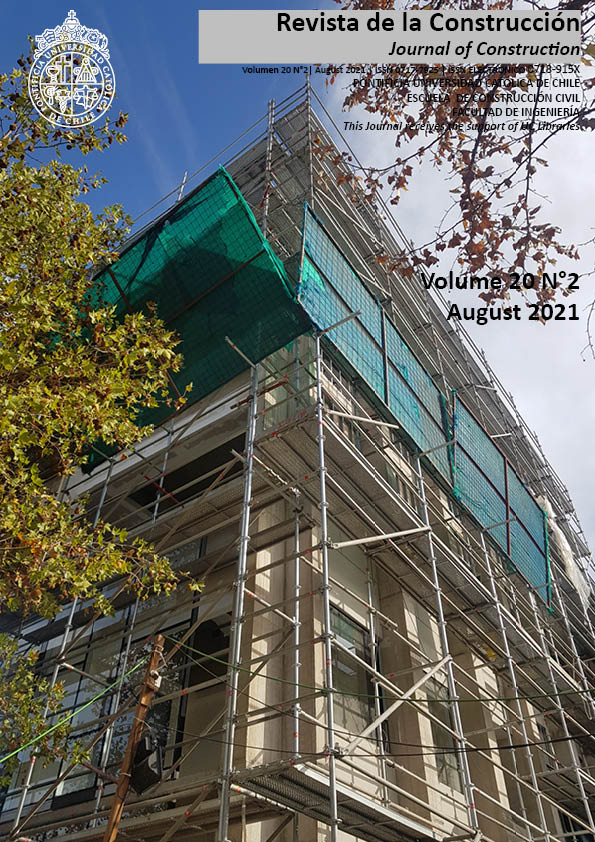Comparative analysis of stress distributions and displacements in rigid and flexible pavements via finite element method
DOI:
https://doi.org/10.7764/RDLC.20.2.321Keywords:
rigid and flexible pavements, ANSYS, stress, displacement, layer thicknessAbstract
In many countries of the world, rigid and flexible pavements are widely used. Some of the external factors such as stresses and displacements play major role in the design of pavement layers such as coating, base and sub-base. Although empirical formulas and methods were used in the calculation and design of the pavement layers, complexity of today's transportation engineering demands effectiveness of the empirical formulas were diminished. Nowadays complex problems can be easily simulated and solved thanks to the higher analysis capabilities of the computer-aided softwares. In this study, the stress distributions and displacements were examined under traffic loads in rigid and flexible pavements with different coating layer thicknesses (30 mm, 50mm, 70mm, 100 mm, and 150 mm) by using finite element method. As a result, the vertical displacement in the flexible pavements were obtained as 5% higher than the vertical displacement in the rigid pavements. Based on the stress distribution results, the stress values of flexible pavements were 60% lower than the stress values of the rigid pavements. Moreover, It was determined that the stresses in the rigid pavements remain in the coating layer, while the stresses in the flexible pavements reach the base and sub-base. In addition, regression models have been developed to predict stress and displacements by using layer thicknesses. High correlation and determination coefficient values (> 0.90) were achieved based on the regression analysis both in flexible and rigid pavements.
References
Ağar, E., Öztaş¸ G., and Sütaş, I. (1998). Concrete roads, Istanbul Technical University Press, Istanbul.
ANSYS Workbench Release 19.0. (2019). ANSYS Inc. Canonsburg. Pennsylvania
Calvarano, L. S., Palamara, R., Leonardi, G., & Moraci, N. (2017). 3D-FEM analysis on geogrid reinforced flexible pavement roads. In IOP Conference Series: Earth and Environmental Science (Vol. 95, No. 2, p. 022024). IOP Publishing.
Çelik, M. (2014). Numerical and cost comparison for Black Sea reagon rigit pavement and flexible pavement and explication test results for rigid pavement samples, PhD. thesis, Karadeniz Technical University, Trabzon, Turkey, (In Turkish).
Erdogan, T. Y. (2003). Concrete. Middle East Technical University Press, Ankara, Turkey.
Gevrek, L. (2008). Layer a road of the produce the distribution of the stress ANSYS computer program with nonlinear finite element analysis, MSc. thesis, Afyon Kocatepe University, Afyon, Turkey, (In Turkish).
Jin, J. M. (2015). The finite element method in electromagnetics. John Wiley & Sons.
Leonardi, G. (2015). Bulletin of the Polish Academy of Sciences: Tech. Sciences 63(2) 397-403.
Li, S., & Hu, C. (2018). Finite element analysis of GFRP reinforced concrete pavement under static load. In IOP Conference Series: Earth and Environmental Science (Vol. 113, No. 1, p. 012188). IOP Publishing.
Mathew,T. V., & Rao, K. K. (2006). Introduction to Transportation engineering. Civil Engineering–Transportation Engineering. IIT Bombay, NPTEL ONLINE, http://www. cdeep. iitb. ac. in/nptel/Civil% 20Engineering.
Mindess, S., Young, J. F., & Darwin, D. (1981). Concrete Prentice-Hall. Englewood Cliffs, NJ, 481.
Mohod, M. V., & Kadam, K. N. (2016). A comparative study on rigid and flexible pavement: A review. IOSR Journal of Mechanical and Civil Engineering (IOSR-JMCE), 13(3), 84-88.
Mulungye, R. M., Owende, P. M. O., & Mellon, K. (2007). Finite element modelling of flexible pavements on soft soil subgrades. Materials & design, 28(3), 739-756.
Özcanan, S., & Akpınar, M. V. (2014). Determination of critical wheel and axle configurations in flexible pavements according to mechanistic analysis. Technical Journal, 25(121), (In Turkish).
Shirzad, S., Aguirre, M. A., Bonilla, L., Elseifi, M. A., Cooper, S., & Mohammad, L. N. (2018). Mechanistic-empirical pavement performance of asphalt mixtures with recycled asphalt shingles. Construction and Building Materials, 160, 687-697.
Shoukry, S. N., William, G. W., & Riad, M. (2008). Aplication of Dynamic Relaxation in Thermo-Elastic Structural Analysis of Highway Pavement Structures, 9ht İnternational LS-DYNA Users Conference. West Virginia University, Morgantown, WV, 26506-6103.
Shoukry, S. N., William, G. W., & Riad, M. (2011). Application of LS-DYNA in Identifying Critical Stresses Around Dowel Bars. In 8th Int. LS-DYNA Users Conference.
Sun, X., Han, J., Fei, J., Guo, J., & Zhang, W. (2020). Geosynthetic-stabilized flexible pavements: Solution derivation and mechanistic-empirical analysis. Geotextiles and Geomembranes, 48(4), 468-478.
Tinni, A.,&Consulting, T. M. (2013). Introduction to concrete pavements. Tinni Management Consulting, EestiBetooniühing–March.
Taghipoor, M., Tahami, A., & Forsat, M. (2020). Numerical and laboratory investigation of fatigue prediction models of asphalt containing glass wastes. International Journal of Fatigue, 140, 105819.
Walubita, L. F., & Van de Ven, M. F. (2000). Stresses and strains in asphalt-surfacing pavements. SATC 2000.
Wang, J., Li, X., Wen, H., & Muhunthan, B. (2020). Shrinkage cracking model for cementitiously stabilized layers for use in the mechanistic-empirical pavement design guide. Transportation Geotechnics, 24, 100386.
Wood, J., & Donnell, E. T. (2020). Empirical Bayes before-after evaluation of horizontal curve warning pavement markings on two-lane rural highways in Pennsylvania. Accident Analysis & Prevention, 146, 105734.
Yanov, D. V., & Zelepugin, S. A. (2019). Road pavement design using the finite element method. In Journal of Physics: Conference Series (Vol. 1214, No. 1, p. 012024). IOP Publishing.





